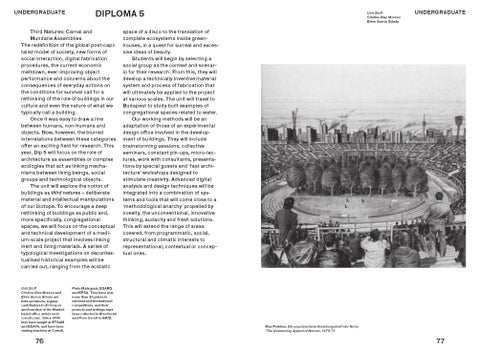undergraduate
diploma 5
Third Natures: Carnal and Mundane Assemblies The redefinition of the global post-capitalist model of society, new forms of social interaction, digital fabrication procedures, the current economic meltdown, ever-improving object performance and concerns about the consequences of everyday actions on the conditions for survival call for a rethinking of the role of buildings in our culture and even the nature of what we typically call a building. Once it was easy to draw a line between humans, non-humans and objects. Now, however, the blurred interrelations between these categories offer an exciting field for research. This year, Dip 5 will focus on the role of architecture as assemblies or complex ecologies that act as linking mechanisms between living beings, social groups and technological objects. The unit will explore the notion of buildings as third natures – deliberate material and intellectual manipulations of our biotope. To encourage a deep rethinking of buildings as public and, more specifically, congregational spaces, we will focus on the conceptual and technical development of a medium-scale project that involves linking inert and living materials. A series of typological investigations on decontextualised historical examples will be carried out, ranging from the ecstatic
Unit Staff Cristina Díaz Moreno and Efrén García Grinda are both architects, regular contributors to El Croquis and founders of the Madridbased office amid.cero9 (cero9.com). Since 1998 they have taught at ETSAM and ESAYA, and have been visiting teachers at Cornell,
76
Unit Staff Cristina Díaz Moreno Efrén García Grinda
undergraduate
space of a disco to the translation of complete ecosystems inside greenhouses, in a quest for surreal and excessive ideas of beauty. Students will begin by selecting a social group as the context and scenario for their research. From this, they will develop a technically inventive material system and process of fabrication that will ultimately be applied to the project at various scales. The unit will travel to Budapest to study built examples of congregational spaces related to water. Our working methods will be an adaptation of those of an experimental design office involved in the development of buildings. They will include brainstorming sessions, collective seminars, constant pin-ups, micro-lectures, work with consultants, presentations by special guests and ‘fast architecture’ workshops designed to stimulate creativity. Advanced digital analysis and design techniques will be integrated into a combination of systems and tools that will come close to a ‘methodological anarchy’ propelled by novelty, the unconventional, innovative thinking, audacity and fresh solutions. This will extend the range of areas covered, from programmatic, social, structural and climatic interests to representational, contextual or conceptual ones.
Paris-Malaquais, ESARQ and EPSA. They have won more than 30 prizes in national and international competitions, and their projects and writings have been collected in Breathable and From Cero9 to AMID. Max Peintner, Die ungebrochene Anziehungskraft der Natur (The Unswerving Appeal of Nature), 1970-71
77
